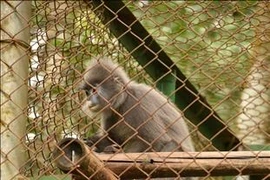Overthe years, Ninh Binh has aggressively implemented measures to conservebiodiversity and sustainably develop the value that natural ecosystems offer.
VanLong Wetland Nature Reserve, Ninh Binh's Gia Vien district, is a completeresidual wetland in the Red River Delta region, comprised of rivers, shallowlakes, and vegetation with distinct ecological characteristics, resulting in adistinctive natural landscape.
VanLong also has high biodiversity value, including two ecosystems, the wetlandenvironment and the limestone ecosystem.
Morethan 720 species of plants from 277 families and six phyla of higher vascularplants can be found in the area, with many included in the Vietnam'sRed Data Book.
Therange of animals is also incredible. There are 39 species of mammals,100 bird species, 38 reptile and amphibian species, 43 fish species,132 insect species, 48 terrestrial mollusc species, and 60 aquaticmollusc species all recorded here.
Notably,Van Long Wetland Nature Reserve homes the greatest number of langurs in Vietnamthat could be witnessed in the wild.
The locationholds two Vietnamese records: "The conservation area with the biggestlangur population in Vietnam" and "The region with the largestnatural scene in Vietnam".
BuiCong Chinh, head of the Hoa Lu-Gia Vien Inter-district Forest ProtectionDepartment, stated that sustainable forest management is crucial foridentifying basic measures in sustainable forest resource management,attracting investment in developing eco-tourism, creating jobs for locals, andimproving the lives of people in the region.
Thedepartment has organized patrols to protect forests, and teams to preventand control forest fires over the years to conserve biodiversity and forestresources. Patrol routes have been built, particularly in key zones andlocations with rare and precious species of flora and fauna, to prevent illegalexploitation, trading, transportation, storage, and processing of forestproducts.
Thedepartment also arranged for staff to visit, gain practical experience in lawenforcement, and increase their knowledge of the environment, land management,and use of sustainable resources.
Theyhave worked with related agencies to finish the reserve's biodiversity projectand unified management of the entire forest land and wetland area. In addition,they have also worked out plans for sustainable management of special-useforests and a management programme for tourism industry in reserve to protect itsintegrity.
TheTrang An landscape complex is located in the area of Hoa Lu special-use forest,with a high level of biodiversity and two major ecosystem types: a limestoneand an aquatic ecosystem.
Biodiversityin Trang An is evident in the diversity of species composition and geneticresources and the presence of numerous endemic and uncommon animal and plantspecies.
Thereare currently 134 plant families, 384 genera, and 577 species describedin the flora of Trang An. In particular, there are 10 species listedin Vietnam's Red Data Book that need to be conserved and sevenspecies that have never been seen before in the country's flora.
TrangAn complex's fauna is also exceptionally diverse, with 30 species ofzooplankton and 40 species of benthic creatures living in the marsh. Thestriped-necked turtle, which can only be found in Trang An, is an endangeredspecies that must be protected.
Notably,after being relocated by Cuc Phuong National Park and the Vietnam WildlifeConservation Centre to the Ngoc Island region of Trang An complex for morethan a year, a langur family has produced its first offspring.
Inthe near future, the Management Board of the Trang An Landscape Complex intendsto breed several endemic and rare species for raising, additional planting,reducing the risk of extinction, and locate suitable sites to establish anartificial habitat and preserve some of these species for biodiversity in thenear future.
In2004, UNESCO identified seven coastal communes within the administrative boundariesof Kim Son district in Ninh Binh, in the buffer and transition zones of the RedRiver Delta Biosphere Reserve.
Theselocations are currently sustaining great biodiversity values with rare speciesof worldwide significance and many rare species documented in the Red Book of Vietnamand the world.
For a green Ninh Binh
NinhBinh has been working for years to find a sustainable approach to developingtourism while still protecting the province's ecology.
Theprovince has swiftly released documents that clarify regulations andlegislation relating to biodiversity, tourism development, and environmentalpreservation in tandem with planning efforts.
Additionally,the province has taken steps to ensure the long-term viability of its naturalresources and created methods to distribute the benefits of biodiversity andecosystem services.
Furthermore,local authorities also provide financial assistance from the state budget toencourage the creation of buffer zones to safeguard local residents' well-beingand prevent logging and wild animal hunting by those who live in or near theforest.
Nguyen Van Duong,head of the Provincial Department of Forest Protection, stated that thedepartment frequently mobilises personnel for forest management and protection,fire prevention and control, as well as biodiversity protection.
According tothe law, they have also increased coordination in patrolling and managingviolations of forest land encroachment, illegal trading of forest products,and wildlife trafficking.
In thefuture, the forest protection authority will strengthen coordinationin inspecting, patrolling, and protecting forests, particularly in special-useforests and protection forests.
Thedepartment will also coordinate regulations between ranger forces and borderingareas in preventing and handling violations; mobilise people to actively planttrees and engage in forest protection and development; preventillegal trade or consumption of forest animals or plants; and protectbiodiversity./.





























